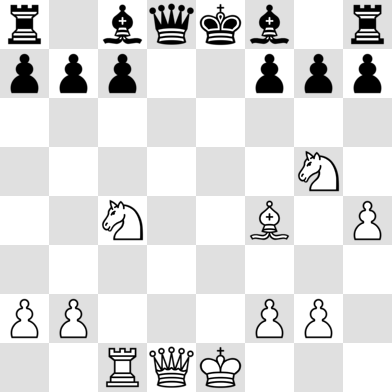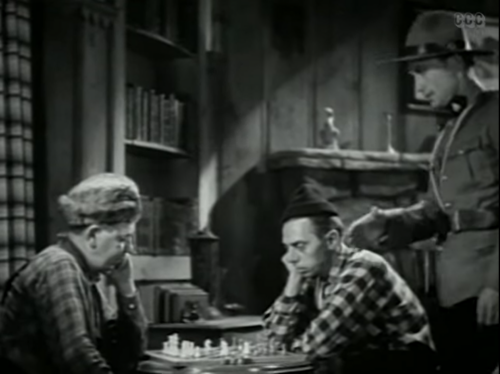In the age-old tradition of Chess in popular culture, we’re going to talk about a franchise which was once huge but has now been relegated to the middens of memory: Renfrew of the Royal Mounted. Who of the what? I hear you ask. Well, Renfrew is a character who was invented by a certain Erskine for a series of children’s adventure books. He is a member of the Canadian Royal Mounted police, a.k.a. the mounties, as an inspector. As such, he goes around apprehending, or at least trying to apprehend, assorted rapscallions.1
Today, we will focus on one of his cinematic forays: a movie released in 1939 under the normal-sounding but actually perfectly meaningless title of Fighting mad. It’s about a lady who witnessed a bank robbery and has been kidnapped by the perpetrators as they flee to Canada. That’s where Renfrew comes in.
In a sort of outpost he meets two taciturn people at the chessboard. The position is very hard to make out. But I haven’t run out of imagination yet, so here goes:2
 The image quality is not good enough for to say anything with any kind of confidence. I can say that black clearly intended to move some piece on the queen’s side. But Renfrew stops him and suggests h6 instead.
The image quality is not good enough for to say anything with any kind of confidence. I can say that black clearly intended to move some piece on the queen’s side. But Renfrew stops him and suggests h6 instead.
And this is what people forget when they talk about the good old days. Talking to people playing chess, even during the game, even about the game, even while they’re at the board, used to be widespread behaviour. It was apparently even accepted behaviour in the police force.
Realism: 2/5 I can’t be too harsh, as the position shown is mostly a figment of my own imagination. But I can’t be too lenient either, since the white pieces on the king’s side seem to be correct — and worrisome. Where has the rook gone?
Probable winner: Very hard to say, as the position is highly uncertain. But I’ll say white, since Renfrew is advising black.
1. [Disappointingly, the etymology of rapscallion seems to have nothing to do with scallions.] ↩
2. [Nor have I run out of diagram editors.] ↩
